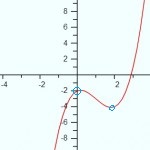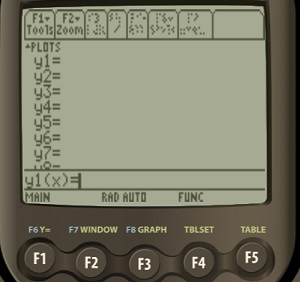
Evaluating a function means to find a y-value for a specific x-value. For example, if you have the function f(x) = 2x, evaluating the function for x = 2 results in a y-value of 2*(x) = 4.
Contents:
- Some Notes on Notation When Evaluating a Function
- Evaluate a Function: Step by Step Examples
- TI-89
- Evaluating an Implicit Function
- When Inputs are Algebraic Expressions
Some Notes on Notation When Evaluating a Function
Most of the time in calculus, we give functions names like “f” or “g” in place of the generic “y”. They are evaluated in exactly the same way. For example, f(x) = 3x is evaluated in the same way as y = 3x.
The following functions are all the same:
- y = x2 + 4x -1 and f(x) = x2 + 4x -1
- y = 3x3 + 12x -10 and f(x) = 3x3 + 12x -10
- y = 9x -1 and f(x) = 9x – 1
Some questions will use function notation to describe a problem.
Example: Evaluate f(x) = 3x + 6 for f(2).
This can be translated into English as “Find the y-value for the x-value at 2”; The f(2) is “the function value at 2” or more simply, the y-value. Plugging in “2” for every x gives:
f(x) = 3(2) + 6 = 12.
Function notation is used to replace the “y” in calculus because sometimes we work with more than one equation at a time. For example, you might have a combination of two functions. For example, two functions f(x) and g(x) can be combined:
f(x) + g(x) = (f + g)(x).
If you used “y” notation instead, the combination would be written as
(y + y)(x),
leaving you to wonder which function is which.
Evaluate a Function: Step by Step Examples
When you evaluate a function, you plug in an x-value and find a y-value. You’ll be given an equation written in function notation; The question might be worded in a few of different ways. You’ll find three different examples below:
- Evaluate f(x) = 2x2 for x = 2 (Example 1), or
- Evaluate f(2) = 2x2 (Example 2),
- Evaluate f(x) = 4x2 – x for f(x + h) (Example 3).
How to Evaluate a Function in Easy Steps
Example question #1: Evaluate f(x) = 2x2 -3x for x = 2.
Step 1: Replace every “x” on the right hand side and the left with the x-value given in the question. We’re told to evaluate the function at x = 2, so:
- f(2) = 2(2)2 -3(2)
Step 2: Solve the right hand side of the equation using the usual order of operations (PEMDAS):
- f(2) = 2(2)2 -3(2)
- f(2) = 2 · 22 – 3 · 2 = 2
- f(2) = 2
That’s it!
Note: If you struggle with order of operations, this Symbolab calculator is a lifesaver!
Example question #2: Evaluate f(9) = 2x2 -5x.
Step 1: Identify the “x” value The x-value is in parentheses on the left-hand side of the equation. The left hand side for this example is f(9), which means our x-value is 9.
Step 2: Insert the value from Step 1 into the right hand side of the equation:
- f(9) = 2(9)2 -5(9) = 117.
Step 3: Solve the right hand side of the equation using the usual order of operations:
- f(2) = 2(2)2 -3(2)
- f(2) = 2 · 22 – 3 · 2 = 2
- f(2) = 2
That’s it!
Example question #3: Evaluate f(x) = 4x2 – x for f(x + h).
Step 1: Identify the x-value given in the question. The x-value here is the “x + h” written in parentheses f(x + h).
Step 2: Replace every “x” on the right hand side and the left with the x-value from Step 1. For this example, that’s x + h, so:
- f(x + h) = 4(x + h)2 – (x + h)
Step 3: Simplify the right hand side of the formula, using algebra:
- f(x + h) = 4(x + h)2 – (x + h) =
- f(x + h) = 4(x2 + 2xh + h2) – (x + h) =
- f(x + h) = 4x2 + 8xh + 4h2 – (x + h) =
- f(x + h) = 4x2 + 8xh + 4h2 – x h.
That’s it!
Evaluate a Function with TI-89

For the TI-89, see: TI 89 graph & evaluate.
Evaluating an Implicit Function
Some functions can’t be solved without a little algebra to get y on the left hand side on its own. For example, if you wanted to solve the implicit equation x2 + 2y = 1:
- Subtract x2 from both sides: 2y = 1 – x2
- Divide both sides by 2: y = (1 – x2)/2
When Inputs are Algebraic Expressions
Function inputs don’t have to be just numbers. You can also input algebraic expressions like x2 or (x – 1) as well. These will sometimes need a little algebra to simplify.
The following examples show various inputs for the function f(x) = 2x + 1:
- f(1) = (2 * 1) + 1 = 3
- f (-2) = (2 * -2) + 1 = -3
- f(z) = 2z + 1
- f(c) = 2c + 1
- f(x2) = 2x2 + 1